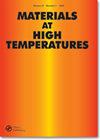New approaches to determine negligible creep
IF 0.9
4区 材料科学
Q4 MATERIALS SCIENCE, MULTIDISCIPLINARY
引用次数: 1
Abstract
ABSTRACT A CEN technical report has been drafted by working group WG59 CEN/TC54 on how to determine no- and negligible creep temperature limits to support EN 13445-3 (Unfired Pressure Vessels - Part 3: Design). Presently the standard assumes “rule-of-thumb” values for no-creep temperatures of ferritic and austenitic steels, 375°C and 425°C correspondingly. It is thought well known that the lower ferritic grades could be creeping below the limit temperature and creep strength enhanced ferritic steels may show significant creep at temperatures well beyond it. Similarly, austenitic steels; nickel and other alloys are likely to have an even wider range of limit temperatures. This paper describes the data assessments and test methods used to determine limit temperatures for a specific set of steels and comparisons are made to other standards and nuclear design codes. The new approaches promote iso-stress testing in the low temperature range and apply Wilshire equation assessments on historical data.确定可忽略蠕变的新方法
WG59 CEN/TC54工作组起草了一份CEN技术报告,内容是关于如何确定无蠕变和可忽略蠕变温度限制,以支持EN 13445-3(未燃烧压力容器-第3部分:设计)。目前,该标准假定铁素体和奥氏体钢的无蠕变温度的“经验法则”值分别为375°C和425°C。众所周知,低铁素体等级可以在极限温度以下蠕变,而蠕变强度增强的铁素体钢在远远超过极限温度时可能表现出显著的蠕变。同样,奥氏体钢;镍和其他合金的极限温度范围可能更大。本文描述了用于确定一组特定钢的极限温度的数据评估和测试方法,并与其他标准和核设计规范进行了比较。新方法促进了低温范围内的等应力测试,并对历史数据应用Wilshire方程评估。
本文章由计算机程序翻译,如有差异,请以英文原文为准。
求助全文
约1分钟内获得全文
求助全文
来源期刊

Materials at High Temperatures
工程技术-材料科学:综合
CiteScore
1.90
自引率
15.40%
发文量
58
审稿时长
>12 weeks
期刊介绍:
Materials at High Temperatures welcomes contributions relating to high temperature applications in the energy generation, aerospace, chemical and process industries. The effects of high temperatures and extreme environments on the corrosion and oxidation, fatigue, creep, strength and wear of metallic alloys, ceramics, intermetallics, and refractory and composite materials relative to these industries are covered.
Papers on the modelling of behaviour and life prediction are also welcome, provided these are validated by experimental data and explicitly linked to actual or potential applications. Contributions addressing the needs of designers and engineers (e.g. standards and codes of practice) relative to the areas of interest of this journal also fall within the scope. The term ''high temperatures'' refers to the subsequent temperatures of application and not, for example, to those of processing itself.
Materials at High Temperatures publishes regular thematic issues on topics of current interest. Proposals for issues are welcomed; please contact one of the Editors with details.
 求助内容:
求助内容: 应助结果提醒方式:
应助结果提醒方式:


